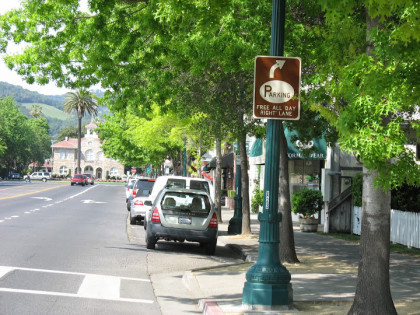Kids, health and the Broadway Oaks
Reader opinion by Lisa Summers
In July I had the pleasure of teaching art to children ages 5-13 at Rhoten Productions Performing Arts Camp. With help from the campers, we transformed a canvas tent in the parking lot behind the Sebastiani Theater to a vibrant art studio where children learned drawing, painting, sculpting, and dollmaking and the crafting of the ever-popular friendship bracelet.
During a watercolor class, the subject of trees came up. Since we spent a good part of the day at the Plaza, we talked about how essential trees are to our own survival and that of other terrestrial beings. When they learned about the City’s plans to cut down the scarlet oaks on Broadway, a sullen and horrified hush descended on the group. Many made drawings and wrote letters to the trees.
Urban trees are getting a lot of attention these days. Psychologists, ecologists, educators, foresters, birders and urban planners are helping to define the critical role of urban forests, including street trees like the Broadway scarlet oaks, at a time when, according to the Global Footprint Network, humans “use the equivalent of 1.5 planets to provide the resources we use and absorb our waste.” Richard Louv, author of “Last Child in the Woods” and co-founder of the Children and Nature Network, wrote a recent article about how the presence of trees in an urban setting helps reduce domestic violence: “by assaulting nature, we raise the odds that we will assault each other. By bringing nature into our lives, we invite humility.” This statement, Louv writes, “isn’t based on modern Romanticism, but on a growing body of mainly correlative scientific evidence, with a tight focus on the impact of nearby nature.”
In the Ontario Health Study (published last month), researchers found that “people who live in neighborhoods with a higher density of trees on their streets report significantly higher health perception and significantly less cardio-metabolic conditions… [We] find that having 10 more trees in a city block, on average, improves health perception in ways comparable to an increase in annual personal income of $10,000 and moving to a neighborhood with $10,000 higher median income or being 7 years younger.”
But children, who are innately more connected to nature than adults, don’t need scientific studies to understand that the true value of trees in our lives far outweighs the cost of sidewalk maintenance. The City’s move to cut down the scarlet oaks on Broadway is not only shortsighted, it sends a direct message to those who do not have a voice in these matters — children, wildlife, the trees themselves — that they don’t matter. And the environmental “services” — if we follow the logic that trees must defend their right to be in a free market economy — dwarf the cost of fixing sidewalks that will inevitably buckle, crack and degrade in this impermanent world.
Trees are, in fact, one of the only infrastructure investments that increases over time. A significant amount of money and time was already spent to plant the scarlet oaks, and the replacement trees will be little more than water thirsty, shade-less sticks in the ground for years to come.
It’s time to reconcile our decisions with shrinking resources, the fragility of world we live in, and the daunting challenges of our new climate reality — all problems that will be inherited by the very same children who consider cutting down the scarlet oaks nothing less that an act of violence.




